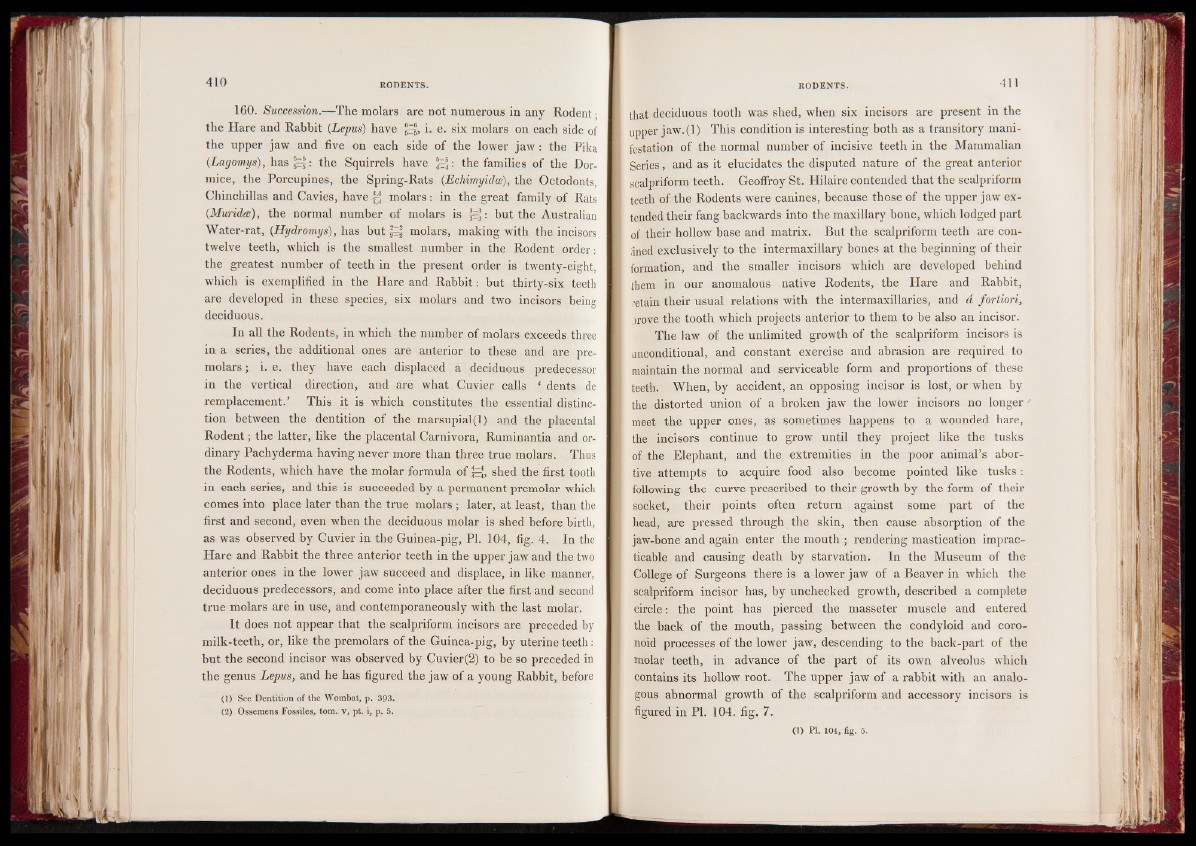
160. Succession.—The molars are not numerous in any Rodent;
the Hare and Rabbit (Lepus) have i. e. six molars on each side of
the upper jaw and five on each side of the lower jaw : the Pika
(Lagomys), has jpf: the Squirrels have : the families of the Dormice,
the Porcupines, the Spring-Rats (Echimyidce), the Octodonts,
Chinchillas and Cavies, have molars: in the great family of Rats
(Muridce), the normal number of molars is Je|: but the Australian
Water-rat, (Hydromys), has but |e| molars, making with the incisors
twelve teeth, which is the smallest number in the Rodent order:
the greatest number of teeth in the present order is twenty-eight,
which is exemplified in the Hare and Rabbit: but thirty-six teeth
are developed in these species, six molars and two incisors being
deciduous.
In all the Rodents, in which the number of molars exceeds three
in a series, the additional ones are anterior to these and are premolars
; i. e. they have each displaced a deciduous predecessor
in the vertical direction, and are what Cuvier calls ‘ dents de
remplacement.’ This it is which constitutes the essential distinction
between the dentition of the marsupial(l) and the placental
Rodent; the latter, like the placental Carnivora, Ruminantia and ordinary
Pachyderma having never more than three true molars. Thus
the Rodents, which have the molar formula of £3, shed the first tooth
in each series, and this is succeeded by a permanent premolar which
comes into place later than the true molars ; later, at least, than the
first and second, even when the deciduous molar is shed before birth,
as was observed by Cuvier in the Guinea-pig, PL 104, fig. 4. In the
Hare and Rabbit the three anterior teeth in the upper jaw and the two
anterior ones in the lower jaw succeed and displace, in like manner,
deciduous predecessors, and come into place after the first and second
true molars are in use, and contemporaneously with the last molar.
It does not appear that the scalpriform incisors are preceded by
milk-teeth, or, like the premolars of the Guinea-pig, by uterine teeth:
but the second incisor was observed by Cuvier (2) to be so preceded in
the genus Lepus, and he has figured the jaw of a young Rabbit, before
(1) See Dentition of the Womhat, p. 393.
(2) Ossemens Fossiles, tom. v, pt. i, p. 5.
that deciduous tooth was shed, when six incisors are present in the
upper jaw.(1) This condition is interesting both as a transitory manifestation
of the normal number of incisive teeth in the Mammalian
Series, and as it elucidates the disputed nature of the great anterior
scalpriform teeth. Geoffroy St. Hilaire contended that the scalpriform
teeth of the Rodents were canines, because those of the upper jaw extended
their fang backwards into the maxillary bone, which lodged part
of their hollow base and matrix. But the scalpriform teeth are conned
exclusively to the intermaxillary bones at the beginning of their
formation, and the smaller incisors which are developed behind
them in our anomalous native Rodents, the Hare and Rabbit,
retain their usual relations with the intermaxillaries, and d fortiori,
prove the tooth which projects anterior to them to be also an incisor.
The law of the unlimited growth of the scalpriform incisors is
unconditional, and constant exercise and abrasion are required to
maintain the normal and serviceable form and proportions of these
teeth. When, by accident, an opposing incisor is lost, or when by
the distorted union of a broken jaw the lower incisors no longer ■
meet the upper ones, as sometimes happens to a wounded hare,
the incisors continue to grow until they project like the tusks
of the Elephant, and the extremities in the poor animal’s abortive
attempts to acquire food also become pointed like tusks:
following the curve prescribed to their growth by the form of their
socket, their points often return against some part of the
head, are pressed through the skin, then cause absorption of the
jaw-bone and again enter the mouth ; rendering mastication impracticable
and causing death by starvation. In the Museum of the
College of Surgeons there is a lower jaw of a Beaver in which the
scalpriform incisor has, by unchecked growth, described a complete
circle: the point has pierced the masseter muscle and entered
the back of the mouth, passing between the condyloid and coro-
noid processes of the lower jaw, descending to the back-part of the
molar teeth, in advance of the part of its own alveolus which
contains its hollow root. The upper jaw of a rabbit with an analogous
abnormal growth of the scalpriform and accessory incisors is
figured in PI. 104. fig. 7.